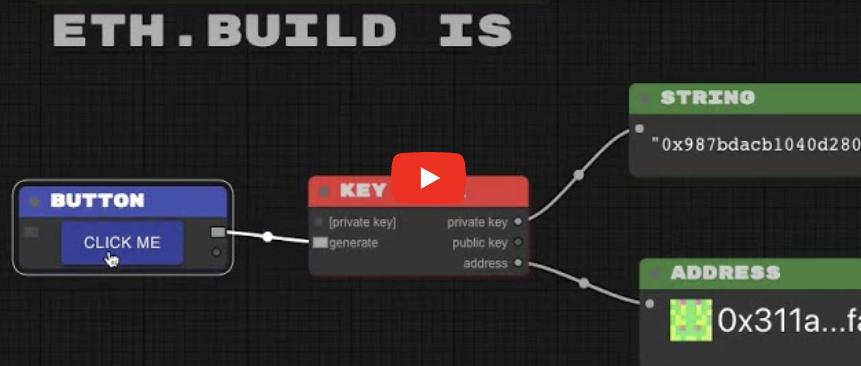Enviornment Information: (reccomended) node version manager node: v14.17.5 yarn: 1.22.5
yarn install --frozen-lockfile --ignore-engines
yarn start
🛠️ETH.Build An Educational Sandbox For Web3... And Much More.
👉Drag-and-Drop Programming 🧩Open Source Building Blocks 🧐Visually Understand How Ethereum Works
Hash Function Think of it like a fingerprint of any given input data. Input can be any size, output is always the same size (64 hex chars). Deterministic, you will always get the same hash for a specific input. One directional, given a hash it is impossible to guess the seed.
Key Pair Consists of a public key derived from a private key. Your address where you send value is derived from your public key. Can be used to sign a message and anyone can recover the signer's address. Anyone can generate an Ethereum account by just generating a random private key.
Look Ahead: Transactions Users can sign messages that go on-chain to send and receive value. No decimals! Amounts are integers, in Wei. 1 ETH is 10^18 Wei. You can generate accounts by just randomly generating private keys.
Side Quest: Encryption Asymmetric encryption with Ethereum key pairs. A small amount of data can be encrypted with a public key. The private key is used to decrypt the data. Not the best way to encrypt data!
Distributed Ledger Once we have key pairs and we can sign messages, our messages can be objects with to, from, value, etc. A ledger keeps track of everyone's balance and new transactions are added to it. Everyone keeps a copy of the same ledger. Need a 'nonce' to prevent replay attacks. Problems with network topology and consensus...
Byzantine Generals Coordination problem arises without a centralized authority. Network (communication) is public and untrusted. Generals prove their ability to wage war to other generals in messages. Proof of work!
Blockchain Proof of work is brute forcing a one-way hash function. Miners with special hardware work to secure blocks of transactions. Each block references the previous block to make a chain. Longest chain wins and your weird uncle shows up to help with security.
Transactions Send value by signing an object with the details like 'to', 'value', 'data'. 'From' address is cryptographically recovered from the signature. No decimals! Amounts are integers, in Wei. 1 ETH is 10^18 Wei. Miners are incentivized with a fee to package transactions into blocks. This fee is called the gas price and you 'bid' to get mined.
Smart Contracts Send 'machine code' as data in a transaction without a 'to' address. Deployed code has an address just like an "externally owned account" with a private key. Reading data is cheap and can come from any node on the network. Storage and execution are relatively expensive. All nodes have to run and store everything. Call a function on a contract by sending it a transaction with the function args in the data.

